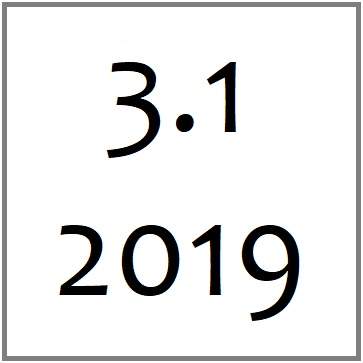Weaponizing Wardrobes: Reckoning with History, Blackness, and Embodiment
T.J. Tallie, University of San Diego
In August of 2014 I pulled my trusty ten-year old Toyota Corolla into a parking lot in Lexington, Virginia. As I stepped out of my car and into the bright, humid central Virginia summer sunshine, my eyes first took in the bone white columns and blood red antebellum brickwork of Washington and Lee University, my new place of employment as a tenure-track professor fresh out of a history doctoral program in Illinois. While I had visited the campus as part of my interview in February, it suddenly felt very real. As a queer, fat, black man from Los Angeles, I was the rural Southern university’s new assistant professor of African history; one of three full-time African-American faculty on a campus founded in 1749 and named after two prominent slaveowners, one of whom had commanded the forces of the Confederacy during the Civil War. “Oh, shit,” was all I muttered that first day, squinting across manicured green lawns and grand architecture that had been built and maintained for generations by people who looked rather like me. “What have I gotten myself into?”
That anxious summer realization began my academic sartorial journey. As I blinked in the mid-afternoon heat, sweat running down my face: all of the old familiar feelings came rushing back—I don’t belong here, They’re all going to find out that you don’t fit, How could you presume to take up space at such an institution—and I felt my blood run cold with both new job anxiety and the weight of two and a half centuries of elite Southern privilege surrounding my unwieldly body. As I struggled with this onrush of feeling, I thought of the theorist Sara Ahmed’s analysis of bodies, belonging, and inhabiting. “What I remember, what takes my breath away, are not so much the giddy experiences of moving and the disorientation of being out of place, but the ways we have of settling,” asserts Ahmed in Queer Phenomenology. Ahmed speaks of “inhabiting spaces that, in the first instance, are unfamiliar but that we can imagine—sometimes with fear, other times with desire—might come to feel like home. Such becoming is not inevitable” (Ahmed, 2006, p. 10). As I stood and contemplated what it meant to find a new home in this space, to make my body welcome, I thought further about how I covered this body and how I moved through the world. This thinking offered a form of embodied rhetoric as I contemplated my own physical form existing across the contemplated spatial, visual, and cultural modes of my new Southern location. As a result, I began to think about the power of fashion in moving through a new and potentially threatening landscape.
How can fashion create a quotidian escape, a knowing performance in the midst of oppressive structures explicitly designed to exclude your body? In my four years at Washington and Lee University in Virginia, I cultivated a particular form of fashion aware of the multiple identities I inhabit: I’m an able-bodied, cisgender black queer male in the academy, who teaches on the intersections on race, gender, and sexuality in a colonial context. What has it meant to do this in an exclusive Southern university, named after slaveholding leaders and built with the unfree labor of fellow black peoples? Further, what does it mean to do this in a place with a high degree of sartorial conformity and highly gendered policing of appearance?
This essay will explore what I mean by ‘weaponizing’ fashion both at Washington and Lee University and now at the University of San Diego. As a queer, black, fat professor, weaponized fashion is a way of wearing clothing that makes me even more aware of the way my body takes up space than usual. While I am both able-bodied and a cisgender male, factors that make clothing more ‘accessible’ in certain ways, I purposefully deploy fashion as a way of calling attention to the spaces that are not designed to receive my body easily. Weaponizing fashion, repurposing history, and redirecting narratives are ways of reclaiming spaces denied queer, black, and fat bodies. Secondly, I will examine the interlocking histories of structural oppression and resistance at play in crafting a daily practice of weaponization. I draw from black feminist and queer theory primarily in order to discuss why and how my clothing practices are personal and quotidian series of challenges to dehumanization and erasure, an attempt to claim spaces not traditionally viewed as belonging to a body like mine. Finally, working with my fashion blog, Clockwork Black (http://clockworkblackblog.wordpress.com), I argue that my sartorial statements gesture to a form of praxis within the dehumanizing spaces of the university and imagine a playful, combative alternative. My body, thus costumed, offers an embodied multimodal rhetoric that challenges existing cultural and historic processes.
Weaponized Fashion
I draw from a wide range of influences for thinking of how I create this idea of weaponized fashion. This idea of fashion as a daily praxis, both in and outside the classroom, was first modeled for me by an undergraduate professor of mine at the University of California, San Diego, Nancy Caciola. Caciola deploys a sense of history and playfulness in her sartorial choices that not only underlines her mastery of the subject, but also casually challenges the experience of working at a university that was never planned with queer, women, or non-white professors in mind. I fondly remember classes where Caciola, a medieval historian focusing on gender, the spirit world, and sainthood, would wear mock chainmail dresses or hand-embroidered pieces that invoked armor plate. I was astounded at this daily display of authority and playful self-confidence. I wrote in my notebook after one lecture, “This is the kind of professor I want to be.”
It is this casual, daily lived challenge to structures of exclusion by Caciola that highlights the destabilizing power of weaponized fashion in a university that historic never made space for a body like yours. As a queer, black, fat professor, weaponized fashion signifies a way of wearing clothing that makes me even more aware of the way my body takes up space than usual. This theorization is entirely indebted to the insights of the Dr. Crystal Boson and her “weaponized cuteness.” Boson recognized that her look is
born of choices I make when I put together my appearance. My cuteness is one aspect of the armor I put on every day to navigate my Black body in a particularly white landscape. When I say that my looks are cute, I am not grounding this in the juvenile or frivolous. My cuteness is situated in my declaration of my agency, my Queer identity, and my investment in very specific forms of performance. I say that this look is weaponized, because I use my body and cuteness as a text to aggressively disrupt narratives that present Blackness, fatness, and Queer forms of identity as marginal, unseemly, unattractive, and unworthy. (Boson, 2014)
Like Boson, my fashion is acutely aware of the multiple identities I inhabit: I’m an able-bodied, cisgender black queer man in the academy, who teaches on the intersections on race, gender, and sexuality in a colonial context. To purposefully delimit space in an institution that diminishes one’s own autonomy and sense of belonging requires weaponization.
By weaponization, I don’t mean wearing spiky things, or carrying a mace (although a decorative mace is a tempting fashion accessory, I freely admit). Rather, weaponized fashion requires a purposeful deployment of style that borrows upon raced and gendered scripts and plays with them. It’s a ludic approach that’s still very serious about how one can occupy a space that was not (and still is not) designed for or actively considers bodies of color, fat bodies, or queer bodies. It’s a sassy armor. It’s an absurd top hat, bracelet, and a neo-Victorian black beard. It can require the use of brooches seen more often as old white lady fashion but being repurposed on waistcoats and with top hats. It’s being able to laugh, snarl, and snark—all with clothes.
Clockwork Black: Occupying Spaces and Reckoning with History—One Selfie at a Time
One year into my employment at Washington and Lee I began to record my outfits on fashion blog. I titled the blog Clockwork Black as a riff on the film Clockwork Orange and to address what it meant to be a queer black academic using steam-punk inspired, nineteenth-century influenced fashion in my daily clothing. By recording my day to day clothing choices at work, I hoped to push back against the constant feeling of invisibility that I experienced on my campus and to actively claim a space to belong, even if that space was largely digital. In doing so, I chose to embrace the potential of what theorist Minh-ha Pham has termed “networked vanity,” the implementation of “individual and public acts of vanity (particularly those that centrally involve sartorial and corporeal displays of physical attractiveness)” in pursuit of larger social aims beyond self-aggrandizement (Pham, 2015, p. 224).
For me, Clockwork Black served multiple functions. First, the blog gave me a very real space (even if virtual) to feel like I was visible and alive. My daily quotidian self-photography felt like a way to mark my existence, to remind myself that I was seen and visible, if even in the mirrored reflections of my bathroom and cellphone. Indeed, both the phone camera and the actual mirrors in my apartment and in campus bathrooms became reflective amplifiers of myself, replete with all the ambivalence self-surveillance entailed (Rocamora, 2011). I became both hyper aware of my own existence and yet felt empowered to occupy space through this disclosure. Such a disclosure revealed the multiple ways in which embodied rhetoric operates. As feminist rhetoricians have argued, “in addition to the rhetorical power of the material body...the body also carries signifying power, articulating some of any body’s many affiliations. This bodily signification is only one link to a particular group, which is complicated by other links (cultural, historical, geographical, linguistic, etc.)” (Johnson, Levy, Manthey, & Novotny, 2015, p. 40). My posing and sharing linked both the rhetorical and signifying power of embodied rhetoric—I was able to locate my body in the midst of its performance and draw across multiple aspects to find a sense of place. As a fat, queer, black body I felt a certain liberation to the exposure, a claim echoed by blogger Maurice Tracy, who asserted
I live in a world where either body privilege or race privilege is always against me. So I point my camera at my face, most often when I am alone, and possibly bored, and I click; I upload it to instagram, and I hold my breath because the world is cruel and I am what some would call ugly, but I don’t see it. …I want them, you, to see that I am human, and there is a reason why I got to this size, but I owe you no explanation or justification for any part of my existence I owe you no explanation or justification for my smile or my swag or my selfie. Hell I didn’t even owe you this. (Tracy, 2013)
As Tracy affirms, taking selfies is not simply a form of self-indulgent vanity. It is also a powerful act of self-acknowledgment in a world fundamentally shaped by historic denials of bodies. Teaching African history at a predominantly white wealthy campus that housed the grave of a Confederate commander and an unreconstructed approach to the dehumanizing atrocities of slavery that literally built the institution that employed me resulted in a quotidian series of erasures and aggressions. I felt as if bits of my soul were being sloughed off in a cheese grater every day that I passed through the whitened, sepulchral columns of the campus. Pressing click on the phone camera and uploading the images was more than a millennial form of self-indulgence; it was a way of reinserting myself into a space that systematically denied me every day.[1]
Secondly, Clockwork Black encouraged me to experiment with clothing, patterns, and style, all with the possibility of a potential audience. In addition to possessing an easily retrievable archive of individual looks I could then, with input from friends and other internet observers, re-curate, reimagine, and recast particular accessories or patterns with an eye toward new forms of self-representation. The initial motivation for the blog, and the purposeful sartorial display in general, began with a desire to overly embellish nineteenth century forms of respectability, knowing that they would fail to ever truly give me acceptance. Instead, I created a daily archive of photographs that allowed me relatively quickly to move into new clothing genres or forms, while still sticking to a generalized nineteenth-century inspired theme. I was drawn in part to the choice of nineteenth-century steampunk/dandy fashion because of the lengthy history of black peoples occupying Western sartorial trends and literally re-fashioning them into expectations of ostentation, power, and belonging.
As Monica Miller has argued, “black dandyism is a strategy of survival that has a long and multifaceted history” (Miller, 2009). Black people’s deployment of clothing that has been imbued with the exclusionary respectability of white supremacy is both a form of claiming belonging and an opulent and ostentatious form of resistance. Historically, enslaved black people have appropriated Euro-American fashion items in order to craft their own pathways to freedom; historical archives are rife with stories of people obtaining their freedom through recasting clothing in order to successful blend, barter, and bluster their way to freedom (Miller, 2009). It is this history that I sought to tap into when I started curating my clothing every day at work and on Clockwork Black. Doing so connects to the powerful histories of freedom, self-expression, and challenge at the heart of black dandy culture. As Miller makes plain, “the black dandy’s style thus communicates simultaneously self-worth, cultural regard, a knowingness about how blackness is represented and seen. Black dandyism has been an important part of and visualization of the negotiation between slavery and freedom” (Miller, 2009).
In my own research, I frequently write about the ways in which African peoples challenged European settler claims to power and authority over their bodies in the nineteenth-century colony of Natal in Southern Africa. Part and parcel of the claim to colonial domination was an assertion that Africans were inherently backward and in need of the uplifting civilizational power of European control (Tallie, 2019a). Although not settlers themselves, missionaries were often directly complicit in this rhetorical effort and expected Africans to adopt Christianity as a marker of civilizational change. For many missionaries in nineteenth century Natal, the only visible measurement of African Christianity was their adoption of European mores regarding clothing and domestic inhabitance; considerable amount of writing was dedicated to the uncivilized nature of African clothing or the ‘incorrect’ way in which Africans adapted European fashions (Tallie, 2016). On the brief occasions when Africans adapted to European styles that closely replicated hegemonic expectations, settlers reacted with fear and disdain. When Mary Anne Barker, wife of the governor of Natal, visited an African Christian community and observed the fashions of the women within, she reacted with a curious mix of admiration and derision.
I was specially invited to look at the contents of the good wife’s wardrobe hung out to air in the garden. . . . I did not possess anything half so fine. Sundry silk dresses of hues like the rainbow waved from the pomegranate bushes; and there were mantles and jackets enough to have started a secondhand clothes shop on the spot (Barker, 1879, p. 205).
Barker’s reaction is particularly telling. She expected African men and women to emulate European sartorial designs in order to reinforce her own primacy in a settler society. Yet, when Africans did so, they threatened the very order that Europeans hoped to import in a white supremacist system. Barker’s snide retort and admission of her own insecurity reveals the destabilizing potential of black bodies occupying and subverting Euro-American styles on their own terms.
Thus, when I pair a vest and hat, and perfect a gaze behind pince-nez, monocle, or acetate frames, I am explicitly choosing and curating my look as a means of survival. It is a form of historic play that not only brings pleasure but re-enacts strategies of fugitivity and endurance. As Miller argues
Anyone can be in vogue without apparent strategy, but dandies commit to a study of the fashions that define them and an examination of the trends around—which they can continually re-define themselves. Therefore, when racialized, the dandy’s affectations (fancy dress, arch attitude, fey and fierce gesture) signify well beyond obsessive self-fashioning—rather, the figure embodies the importance of the struggle to control representation and self- and cultural-expression. (Miller, 2009)
The archive accumulated then in Clockwork Black is a serious study of everyday resistance, of purposeful posing in mirrors and posing through histories of oppression and marginalization. Indeed, as a tenure-track faculty member, I listed Clockwork Black every year in my annual evaluations of faculty activity, both at Washington and Lee and now here at the University of San Diego. For me, the accumulation of these images is not only constructing an archive of embodied resistance; it is also a purposeful form of academic labor. In addition to the regular duties of teaching, research, and academic service, I am also doing daily performative work in and outside the classroom with my fashion. I am telling a narrative, occupying a space, reframing my claims to belong. It is far from a merely frivolous act or a mere affectation; as Pham has described, Clockwork Black and my quotidian sartorial choices are part of a wider praxis of networked vanity, a pleasurable experience of self-armoring that tells a narrative even as I teach in buildings never designed for my body.
That is not to overstate the power, reach, or efficacy of this undertaking. I am well aware of the fact that this work is symbolic and personally powerful but is not necessarily world-changing. I do not believe that a selected waistcoat, worn on a muggy Virginia September day, or a shared photograph of a tweed cap from which the flyaway curls of my black heritage escape, will end structural racism. Nor am I ignorant of the fact that such a practice is only possible because of intersecting privileges that exist simultaneously with my historic marginalizations. I am a cisgender man even as I am black, fat, and queer. In academia and in fashion in general, there is far less of a likelihood that my body will be subject to the structural, panoptic gaze that my female colleagues undergo. To put it simply: I have the latitude to be eccentric and ludic with my fashion choices and not have it reflect immediately on my academic performance either with my colleagues or my students. The marked difference between my student evaluations and my female colleagues is ample evidence of this.[2] In my five years of weaponized fashion, my clothing has elicited one single mention in a student’s course evaluation, an essential part of the tenure evaluation process for an assistant professor like myself. This is not the case for my female counterparts, who must navigate daily a sexist system of embodied judgment that also trivializes their fashion as frivolous while also dedicating outsized importance to what every piece of cloth signifies about their capability to teach (Baker, 2015). Similarly, Clockwork Black does not exist within the highly ambivalent space of women’s fashion blogs that simultaneously operate within and are disciplined by a gaze that seek to constrain women’s bodies (Rocamora, 2011).
These insights were not reached in isolation. In October 2017 I was invited to give a talk in Wellington, New Zealand about the disruptive and decolonial potential of “weaponised fashion.” Similarly, in March 2019, nearly a year after leaving the institution, I was invited back to Washington and Lee to give a lecture on weaponized fashion as a professor. Both talks were met with thoughtful, considered critique, and I’m grateful for the challenges offered both in Aotearoa and the Old Confederacy. Of particular concern to both audiences were questions of scale and acknowledgments of relative privilege in being able to undertake this work with Clockwork Black. I think it appropriate to recognize that academic work can be significant but also not radically transform lived structural oppressions. In addition, to be able to buy and curate clothing requires investment; it is not something simply available to everyone given the financial outlays necessary to do the work. I neither imagine the work I do with Clockwork Black to be all-encompassing, nor do I see it as a universal template that all people can also replicate. The work that my snarky clothing perambulations do is fun, liberating, and significant, but it is not comprehensive. I am as eager to stay in my lane as an academic as I am to deconstruct, challenge, and playfully destabilize historic structures of oppression, one waistcoat at a time.
I spend the remainder of this article analyzing several outfit choices from Clockwork Black over the last four years. This requires not simply describing the outfits or relaying the reason behind their description. This also necessitates a thoughtful appraisal of the image itself and its situation within larger historic contexts in Virginia (and later in California). To do this, I am particularly challenged by the theoretical work of scholar Tina M. Campt at uncovering the everyday power visible in images of black people in a world structured by white supremacy. In Listening to Images, Campt explores the myriad ways in which black people articulate and define for themselves a futurity in the midst of histories of silencing and erasure. Studying state-sponsored photography in ethnographic work, passport photographs, or carceral spaces, Campt interprets these images in a markedly different way; she chooses to listen to the images, focusing on the feelings elicited by these everyday objects, when examined in larger social contexts. For Campt, “‘listening to images’ is at once a description and a method. It designates a method of recalibrating vernacular photographs as quiet, quotidian practices that give us access to the affective registers through which these images enunciate alternate accounts of their subjects. It is a method that opens up the radical interpretive possibilities of images and state archives we are most often inclined to overlook” (Campt, 2017, p. 5). Campt locates within these images, the power of the quotidian, “the struggle to create possibility within the constraints of everyday life” for black people in white supremacist societies. The quotidian practice of daily selecting clothing that will cover the body and create moving images, can create profound frequencies of feeling for observers; these quotidian actions are “mobilized as everyday practices of refusal” (Campt, 2017, p. 5). While the images in Clockwork Black are not state-ordered, they are quotidian examples of black self-expression within a historically exclusive institutional space, and similarly can benefit from a careful listen. By listening to these images of my body, we explore the power of embodied rhetoric across visual, spatial, and aural modes—we merge the symbolic and the rhetorical and make visible previously hidden histories of labor and violence (Johnson et al., 2015, p. 39).
Figure 1: Black-n-Red (September 22, 2015)
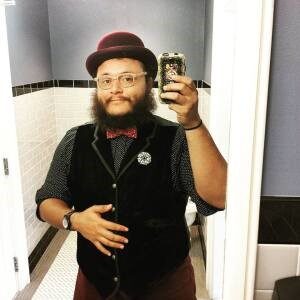 |
This was one of the first photos I ever uploaded to Clockwork Black, and it incorporated many of the items that became regular parts of my daily sartorial choices (Tallie, 2015). I paired a black polka dot dress shirt with maroon canvas nineteenth-century pants, secured by reproduction suspenders. I added a red floral bowtie, maroon bowler hat, and a velvet black vest, to which I attached a sparkly gold brooch. The overall look is generally a simple bichromatic look of red/black, invoking both my racial heritage and the blood that went into the institution every day. The red also points to the anti-indigenous originary violence that created the possibilities of enslavement at education at Washington and Lee. The color scheme is embellished by nineteenth century touches—the hat, vest, and pants styles are all indicative of a Gilded Age era aesthetic. Following Campt’s lead, we can then turn to the photograph itself and listen to what the image itself tells us through this quotidian practice. As a photographic subject, I’m posed calmly, yet directly looking into the camera, daring the viewer to see me, to occupy space even as I wear these formal garments at work. The seeming placidity of my pose and expression suggest what Campt would term a quotidian refusal, “practices honed in response to sustained, everyday encounters with exigency and duress that rupture a predictable trajectory of flight” (Campt, 2017, p. 10). I think of this image in relation to the blood-red bricks of the historic campus colonnade at Washington and Lee; I think of the enslaved African peoples who had to build and maintain these structures and their descendants who were systematically excluded from attending the institution. I take on this challenge by placing these histories sartorially on my body; histories that were already marked historically on skins like mine, and now arranged symbolically, purposefully in this image as an embodied rhetorical act. The location of this photograph is also intentional; I took the picture on campus, in a newly retiled bathroom near my office. It felt symbolic and important to repurpose the spaces of the campus for my own desires, beyond those of the institution. I allow myself a bit of playfulness by reappropriating a garish gold brooch that I had acquired at an antique mall; the piece hints at femininity and type of older respectability practiced by older women in the professional world, and thus it makes a fun and confusing juxtaposition overall. I think about the absurdity and the tension of having the privileged position of assistant professor in a place where black bodies like mine had only been seen until recently as background laborers. My half-smile and placidity, then, is a quotidian refusal, not an escape from the institution, but a direct decision to occupy space that had previously not been mine to claim. I think of the quiet confidence of refusing histories of erasure, and I think of the audacity of wearing a velvet vest and a bowler hat in a place where my ancestors were denied space.
Figure 2: Wakanda Forever (February 27, 2018)
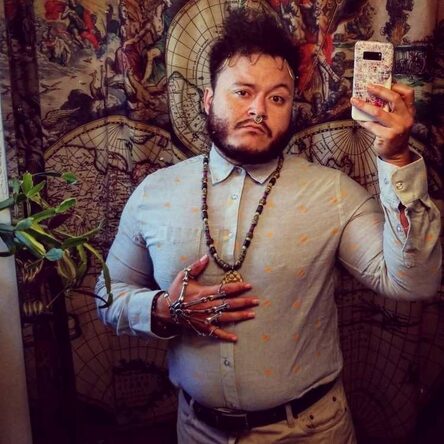 |
Three and a half years into my time at Washington and Lee, I decided to wear this relatively simplified outfit to work (Tallie, 2018). The dress shirt is a light blue with stylized sunrise patterns, paired with a simple pair of jeans. However, I’d also added purposeful accessories: first, a copper wire minimalist crown headpiece, a West African bead necklace, and a skeleton handflower bracelet. While there is something a bit playful or even costumey about this (my hand is a literal skeleton, something my students laughingly pointed out throughout the day), there is a larger point in the midst of the lighthearted touch. Together, these pieces tell a different story of space and challenge. The photograph’s regal elements, combined with the self-assured facial expression in the image, are more confrontational than the previous piece. They speak to an aggressive occupying of space, and a recasting of a future. I named this piece Wakanda Forever, after the statement in the mythical African kingdom of Wakanda in the Marvel comic and film, Black Panther. While Wakanda is not a real place, and not without its own limitations, invoking it can be a call to somewhere beyond the daily realities of enslaved histories and violence. Doing so reflects Tina Campt’s articulation of black feminist futurity, which offers a:
grammar of possibility that moves beyond a simple definition of the future tense as what will be in the future. It moves beyond the future perfect tense of that which will have happened prior to a reference point in the future. It strives for the tense of possibility that grammarians refer to as the future real conditional or that which will have had to happen. The grammar of black feminist futurity is a performance of a future that hasn't yet happened but must. It is an attachment to a belief in what should be true, which impels us to realize that aspiration. It is the power to imagine beyond current fact and to envision that which is not, but must be. It's a politics of pre-figuration that involves the living future now—as imperative rather than subjunctive—as striving for the future you want to see, right now, in the present. (Campt, 2017, p. 17)
After three years of teaching at Washington and Lee, I was exhausted. I was one of only four African-American faculty on the campus, I was one of less than ten out queer faculty, and the only person to identify as both. I was tired of being the point person for students (and colleagues in crisis). I was exhausted with the endless trotting me out by the administration as a sacrificial offering on the altar of performative change. I was tired of being the expected physical bridge between a racially oppressive history and an imagined inclusive global elite college. I didn’t want to live in the quotidian exhaustions of February 2018. I wanted a future that will have had to happen. I wanted to invoke the histories of violence and enslavement and oppression in my skeletonized hand, but I also wanted to imagine a pan-African, autonomous position within the ruins of the institution’s violent white supremacist past.
Figure 3: Ancient Egypt, Modern Style (February 18, 2019)
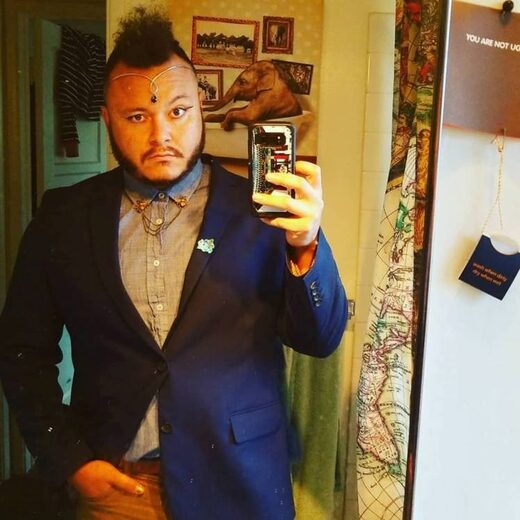 |
Listening to the powerful frequencies in this photograph, I feel the juxtaposition of death and decay in the bony finger jewelry with the stubborn Christmas cactus that had begun to snake its way into many of my photos that spring. I feel life continuing to push, insistent into frames of death and order, their unruly resilience demanding a space beyond the photo’s convention. When I see this photograph, I see a calm but uncompromising claim for a future that must come—a future of genuine liberation, not one where black bodies are offered as a tepid panacea to structural dispossession. I see the future, and I call for it to arrive. Three days later I was offered a job at the University of San Diego.
Six months into working at a new university, I took this photograph (Tallie, 2019b). The University of San Diego is, in many ways, markedly different than Washington and Lee University. It is located back in the southern California in which I was raised and is a place that feels far more familiar than the particularly blunt histories of enslaved violence I encountered in Virginia. Yet, it would be foolish to assume that a simple change of university would end any and all structural histories of oppression or exclusion. As a wealthy, Catholic liberal arts college with a predominantly white student body, the University of San Diego has familiar structural issues for me as a black professor. Indeed, in March of 2019, the university made the news for its inclusion in part of a wider admissions bribery scandal involving affluent parents purchasing spaces for their children (Robbins & Davis, 2019). This is particularly exhausting for black students and faculty, who are often viewed as suspect additions outside of the university proper, and who feel they have to prove themselves over and over again. As Ebony O. McGee and Danny Bernard Martin argued this year, “Being black in the academy too often means enduring ‘racial battle fatigue,’ particularly in spaces shaped by wealth and white supremacy” (“Being a Black Academic in America,” 2019). While the University of San Diego does not directly inhabit spaces of enslavement in the same way as Washington and Lee, it represents an uncomfortable alliance between Catholic histories and genocidal violence committed by the church toward the region’s indigenous Kumeyaay people, a particularly thorny issue at a campus that until recently memorialized the founder of the Catholic mission system, Junipero Serra, in one of their campus buildings (Wilkens, 2019).
What could this mean for my weaponized fashion? In short, it means that my dressing is still necessary to disrupt spaces in which I am not expected to belong; it means challenging conventions of who can be a professor in a space built through structural violence. It means some of the immediate existential factors at Washington and Lee have to shift, and so does my choice of clothing. While teaching about the history of ancient Egypt in an introductory African survey, I decided to put together this simple outfit that incorporated a scarab beetle set of sweater pins over a plain blue dress shirt and under a dark blue blazer. A minimalist headpiece and playful black eyeliner complete the look. For me, the look is elegant, and yet also unexpected. There are less of the immediate adornments of nineteenth century vests or strategic accessories as in Wakanda futurity. Rather, this is a simpler look that also teases at what a “grown up” professor can look like. I look directly at the camera, challenging the viewer to see my body and my work in thinking about Egypt and Africa more broadly, as a series of interconnected stories, especially in my new San Diego location. In asserting an ancient Egyptian history in African classes, I am also trying to pointedly take up space in classes and remind us that black bodies have existed, continue to exist, and aren’t going anywhere anytime soon. Following the advice McGee and Martin offered to black faculty and students in light of the admissions scandal: “Remember that your blackness represents the highest form of excellence. You are enough. The system is what has to change, not you” (“Being a Black Academic in America,” 2019). Nothing quite makes that playful assertion, like minimalist ancient Egyptian elements in the middle of ostensibly grown up professor wear, does it?
Conclusion
Clockwork Black is a work in progress, a way of charting the ways in which my black, fat, and queer body does not immediately or easily fit the expectations people have for a professor, first in rural Virginia and now in urban San Diego. By drawing on a variety of influences, I have crafted a whimsical and absurd fashion blog that simultaneously tires to occupy spaces that my body was never supposed to take up while also remaining playful and ridiculous. Dress has allowed me the necessary space to challenge, flourish, and imagine a world, beyond the limitations of history and the realities of violence. Also, there are so many hats and/or waistcoats, and that may be the greatest gift.
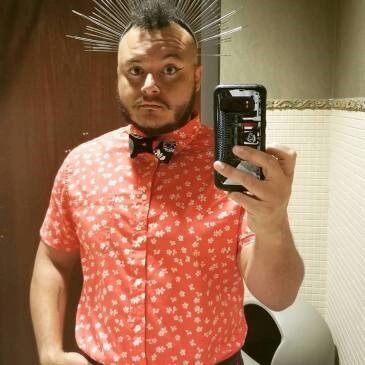 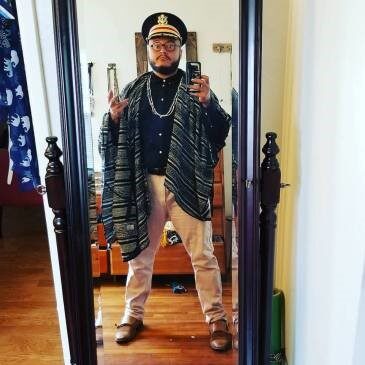 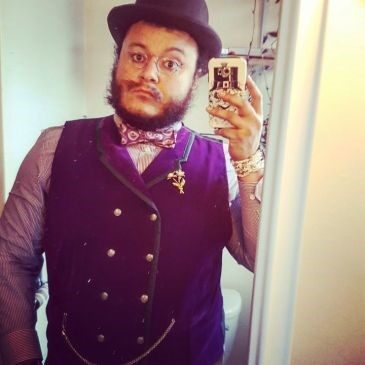
|
Figure 4: A few more of the author's excellent sartorial choices.
References
Ahmed, S. (2006). Queer phenomenology: Orientations, objects, others. Durham, NC: Duke University Press.
Baker, K. J. (2015, August 19). I look like a professor... Retrieved May 13, 2019, from https://chroniclevitae.com/news/1103-i-look-like-a-professor
Barker, M. A. (1879). A year’s housekeeping in South Africa (2nd ed.). London: Macmillan & Co.
Being a Black academic in America [academic blog]. (2019, April 18). Retrieved April 20, 2019, from https://www.chronicle.com/interactives/20190418-black-academic
Boson, C. (2014). Weaponized cuteness [academic/fashion blog]. Retrieved April 20, 2019, from http://www.professordresser.com/
Campt, T. M. (2017). Listening to images. Durham, N.C.: Duke University Press.
Johnson, M., Levy, D., Manthey, K., & Novotny, M. (2015). Embodiment: Embodying feminist rhetorics. Peitho, 18(1), 39–44.
Miller, M. L. (2009, October 15). On her book Slaves to fashion: Black Dandyism and the styling of Black diasporic identity. Rorotoko. Retrieved from http://rorotoko.com/interview/20091016_miller_monica_on_slaves_fashion_black_dandyism_styling_black_ident/?page=2
Pham, M.-H. T. (2015). “I click and post and breathe, waiting for others to see what I see”: On #FeministSelfies, outfit photos, and networked vanity. Fashion Theory: The Journal of Dress, Body & Culture, 19(2), 221–241. https://doi.org/10.2752/175174115X14168357992436
Robbins, G., & Davis, K. (2019, March 13). University of San Diego, local families caught up in college admissions scandal. San Diego Union-Tribune. Retrieved from https://www.sandiegouniontribune.com/news/education/sd-me-cheating-scandal-20190312-story.html
Rocamora, A. (2011). Personal fashion blogs: Screens and mirrors in digital self-portraits. Fashion Theory: The Journal of Dress, Body & Culture, 15(4), 407–424. https://doi.org/10.2752/175174111X13115179149794
Tallie, T. J. (2015, September 25). Black-n-Red | Tuesday, 25 September, 2015. Clockwork Black: Weaponized fashion and the adventures of a Queer Blackademic. Retrieved April 23, 2019, from https://clockworkblackblog.wordpress.com/2015/09/25/black-n-red-tuesday-september-22-2015/
Tallie, T. J. (2016). Sartorial settlement: The mission field and transformation in colonial Natal, 1850–1897. Journal of World History, 27(3), 389–410. https://doi.org/10.1353/jwh.2016.0114
Tallie, T. J. (2018, February 27). Wakanda forever | Tuesday, 27 February 2018. Clockwork Black: Weaponized fashion and the adventures of a Queer Blackademic. Retrieved April 23, 2019, from https://clockworkblackblog.wordpress.com/2018/02/27/wakanda-forever-tuesday-27-february-2018/
Tallie, T. J. (2019a). Queering colonial Natal: Indigeneity and the violence of belonging in Southern Africa. Minneapolis, MN: University of Minnesota Press.
Tallie, T. J. (2019b, February 22). Ancient Egypt, modern style |Monday, 18 February 2019. Clockwork Black: Weaponized fashion and the adventures of a Queer Blackademic. Retrieved April 23, 2019, from https://clockworkblackblog.wordpress.com/2019/02/22/ancient-egypt-modern-style-monday-20-february-2019/
Tracy, M. (2013, March 16). The fat boi diaries: Why selfies? BlaQueer. Retrieved April 22, 2019, from https://blaqueer.wordpress.com/2013/03/16/the-fat-boi-diaries-why-selfies/
Wilkens, J. (2019, April 10). USD will rename Serra Hall to also honor Native American saint. San Diego Union-Tribune. Retrieved from https://www.sandiegouniontribune.com/news/education/story/2019-04-10/usd-will-rename-serra-hall-to-also-honor-native-american-saint
[1] In the bio on my personal Instagram page (http://www.instagram.com/teejasaurus/) I refer to this process as “selfie care.” There is something profoundly useful about the reassurance of daily photographic work against the regularly experienced feelings of displacement.
[2] I remain, as always, deeply indebted to the patience and insights of Dr. Mikki Brock for this.
